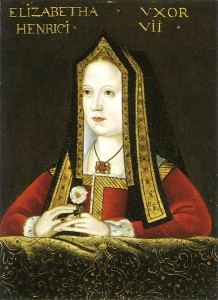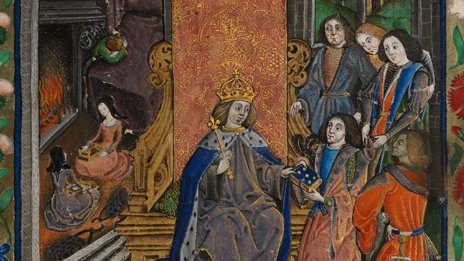
11 February is the date of both the birth and death of Elizabeth of York, consort of King Henry VII. Elizabeth was born on this day in 1466 and she died on this day in 1503.
Elizabeth was the eldest child of King Edward IV and his consort Elizabeth Woodville and was born on 11 February 1466 at Westminster Palace, London. She was baptised in St Stephen’s Chapel in Westminster Abbey, with the Earl of Warwick standing as godfather and her grandmothers, the Duchesses of York and Bedford, standing as godmothers. She was named Elizabeth after her mother and was soon given her own household at Greenwich Palace under the care of Lady Margaret Berners.
Elizabeth’s father, Edward IV, had managed to capture and imprison Henry VI in 1461, dethroning him and taking the crown for himself, starting the royal House of York. However, Edward’s controversial marriage to Elizabeth Woodville caused trouble for Edward when Elizabeth alienated powerful Yorkist supporters, causing them to side with Lancastrians and challenge Edward. The result was that Edward was driven into exile and the throne became Henry VI’s once more in October 1470.
Henry’s reign was short-lived with Edward overthrowing him once again in April 1471. Ex-Yorkists and Lancastrians were defeated in battle, and Henry VI was killed in the Tower. Edward had stamped out his enemies. Unfortunately, tragedy struck the House of York at Easter 1483 when Edward caught a chill on a fishing trip. He died on 9th April, and his thirteen year-old son Edward became Edward V. Edward V was too young to reign in his own right, so his uncle, Richard, Duke of Gloucester, became Protector. To cut a rather long story short, with Edward V and his younger brother, Richard, Duke of York, ‘residing’ in the Tower of London, Richard was crowned King Richard III on 6 July 1483 and the boys disappeared, going down in history as ‘The Princes in the Tower’. It is not clear what happened to them.
Elizabeth of York mourned the loss of her brothers, but her mother decided on revenge, and this is when she decided to approach Lady Margaret Beaufort. Although the two ladies were supposed to be on different sides, Elizabeth being from the House of York and Margaret being a Lancastrian, neither lady was happy with Richard on the throne, and decided that a union between their children could bring about Richard’s downfall. Henry Tudor defeated Richard III on 22nd August 1485 at the Battle of Bosworth Field, becoming King Henry VII, and went on to marry Elizabeth on 18th January 1486. Although the marriage was a political union, uniting the once warring Houses of Lancaster and York, it was happy and successful. Elizabeth and Henry had eight children, although only four of them survived infancy: Arthur, Margaret, Henry and Mary.
On 2nd February 1503, after a long labour, Elizabeth gave birth to her eighth and final child, a little girl called Katherine. Little Katherine died on 10th February and her mother followed her on 11th. It is not known what the Queen died of but it must have been a post-partum infection or complication, like puerperal fever or haemorrhaging. Elizabeth was buried at Westminster Abbey after a lavish funeral. Today, visitors can pay their respects at the magnificent tomb of Henry VII and Elizabeth of York in the Abbey’s Lady Chapel, built by Henry VII.
If you want to know more about Elizabeth of York then I would recommend getting hold of a copy of Amy Licence’s biography of her, Elizabeth of York: The Forgotten Queen of England, which is available from Amazon.com, Amazon.co.uk or your usual bookstore. You can read a review of it on our Tudor Book Reviews site – click here.
Trivia: During Elizabeth of York’s childhood, she was betrothed to George Neville, son of John Neville, Marquess Montagu, and then to Charles the Dauphin, son of Louis XI.
This image is from the Vaux Passional and is thought to depict Henry VII and his children mourning the loss of Elizabeth. The figure weeping on the bed is believed to be Prince Henry (the future Henry VIII) and the girls in front of the bed are believed to be Princess Margaret and Princess Mary.

Notes and Sources
- Ridgway, Claire (2012) On This Day in Tudor History, MadeGlobal Publishing.
- Licence, Amy (2013) Elizabeth of York: The Forgotten Queen of England, Amberley Publishing
- Horrox, Rosemary (2004) Elizabeth (1466–1503), Oxford Dictionary of National Biography, Oxford University Press
- The Vaux Passional, the National Library of Wales.
I’ve always loved that illustration. It’s so human, the little boy crying on the bed.
Henry V111 said the day his mother died was the worst day in his life, I think he revered her memory all his life and maybe was searching for someone like her in all his wives?
So sad about mother and baby Katherine dying within 24 hrs of each other,Elizabeth has that beautiful tomb in Westminster,was Katherine layed there too I am wondering?
Henry Tudor never married again and it is doubtful that he had a mistress either. He became friends with Lady Katherine Gorden, widow of the late executed Richard of England, Duke of York and Norfolk/Perkin Warbeck, cousin of King James of Scotland, but not in a romantic way. Elizabeth had been a good wife to Henry, as the heir to the throne she was his key to the throne, the mother of his children, several of them, with three adults alive at her death, she was his helpmate and she appears to have been revered and admired. Elizabeth of York was no mere passive witness of history, she was part of it. As a newly released teenager from her mother’s self imposed sanctuary, Elizabeth had found life at the Christmas court of her uncle Richard iii so fascinating that she had become fond of him to the extent that sources indicated that Richard iii wanted to marry her.
Croyland gives the most distorted view of Elizabeth and Richard during Christmas 1484 through to the death of his wife Anne, turning favouritism shown by Anne to befriend Elizabeth as proof that he would marry her. This was quite impossible and Richard was more likely to find her a husband to stop her becoming the wife of Henry Tudor. Elizabeth herself was taken with Richard, she says so in her own words, her letter to Norfolk for example, but this was probably a teenager denied human contact for several months, coming of age, glad to be back at the central powerbase, the English court, dancing and having fun. Richard iii was persuaded to give a public devil that he did not want to marry Elizabeth. Henry Tudor, himself knew that Elizabeth could fall through his claim as he tried to seek out an alternative bride with royal blood, Maud Herbert. But, fate intervened, in the person of Margaret Beaufort and the Battle of Bosworth.
Margaret Beaufort and Elizabeth Woodville plotted the marriage of Elizabeth of York and Henry of Richmond. Margaret risked being executed as a traitor but Richard lll was not a man to kill a well respected woman for this, in fact no woman was executed for treason under the Plantagenets. She was put under the control of her husband, Lord Thomas Stanley but continued to plot to get support for Henry. To some extent his support depended on his marriage with Elizabeth of York. However, Penn has said that his keeping the crown did not depend on Elizabeth.
It was very probable that Elizabeth at the end of the day had much choice but to marry the victorious Henry Vll, but she agreed to do so, fulfilling her role as the mother of a future King, the evidence is that she mourned her brothers, that she was torn apart when Perkin Warbeck came to claim that he was Richard, the younger Prince in the Tower, but she remained a good wife to Henry Tudor. She even made the decision that cost her own life, in order to console him after the death of Prince Arthur. By having a child, the Princess Elizabeth, which she hoped would be a son to replace Arthur, when her health was not good, Queen Elizabeth of York put her life at risk. She died not long after the death of the child. Henry was devastated, he never married again, it’s clear that he was fond of her, and they lie together in the new rose Lady Chapel in Westminster Abbey. Elizabeth was loved, loyal, proud and the memorials to her full of praise for all her qualities. She was also lively, fun loving and headstrong, much like her mother.
Yes, very sad indeed …..
This is the real Tudor love story. Not Henry VIII and his six wife soap,opera.